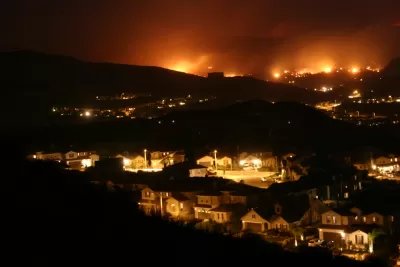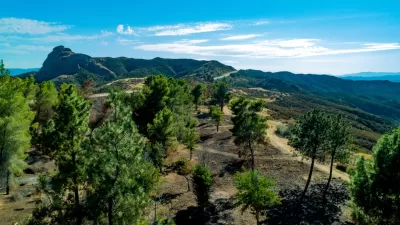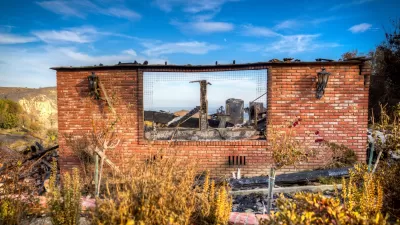With limited action at the state level, communities in vulnerable areas have launched their own local preparedness programs and plans.

Doug Smith and Ben Welsh report on a Los Angeles Times analysis of buildings located in hazardous wildfire areas in California. "More than 1.1 million structures, or roughly 1 in 10 buildings in California, lie within the highest-risk fire zones in maps drawn by the Department of Forestry and Fire Protection, the analysis showed."
The highest concentration of these structures is in Los Angeles, where 114,000 homes, industrial buildings, and other buildings are located in high-risk areas. San Diego follows with 88,000 buildings. Areas where cities butt up against rocky terrain are the most vulnerable, note Smith and Welsh.
"Although they identify areas where stricter building standards and brush clearance are required, the maps do not directly trigger land-use restrictions or funds to make communities less vulnerable," say Smith and Welsh. The state mandates building codes, but retrofitting existing buildings and disaster preparedness remain largely the responsibility of local jurisdictions and fire departments.
Some communities in Southern California have taken the initiative to prepare for wildfires, where residents and local governments have organized volunteer arson watch and emergency response teams, conducted fire risk assessments, and held public meetings about safety and evacuation plans. However, many of these efforts still remain largely untested, since these are areas that were minimally affected by recent wildfires.
FULL STORY: A million California buildings face wildfire risk. ‘Extraordinary steps’ are needed to protect them

Alabama: Trump Terminates Settlements for Black Communities Harmed By Raw Sewage
Trump deemed the landmark civil rights agreement “illegal DEI and environmental justice policy.”

Planetizen Federal Action Tracker
A weekly monitor of how Trump’s orders and actions are impacting planners and planning in America.

Why Should We Subsidize Public Transportation?
Many public transit agencies face financial stress due to rising costs, declining fare revenue, and declining subsidies. Transit advocates must provide a strong business case for increasing public transit funding.

Understanding Road Diets
An explainer from Momentum highlights the advantages of reducing vehicle lanes in favor of more bike, transit, and pedestrian infrastructure.

New California Law Regulates Warehouse Pollution
A new law tightens building and emissions regulations for large distribution warehouses to mitigate air pollution and traffic in surrounding communities.

Phoenix Announces Opening Date for Light Rail Extension
The South Central extension will connect South Phoenix to downtown and other major hubs starting on June 7.
Urban Design for Planners 1: Software Tools
This six-course series explores essential urban design concepts using open source software and equips planners with the tools they need to participate fully in the urban design process.
Planning for Universal Design
Learn the tools for implementing Universal Design in planning regulations.
Caltrans
Smith Gee Studio
Institute for Housing and Urban Development Studies (IHS)
City of Grandview
Harvard GSD Executive Education
Toledo-Lucas County Plan Commissions
Salt Lake City
NYU Wagner Graduate School of Public Service





























